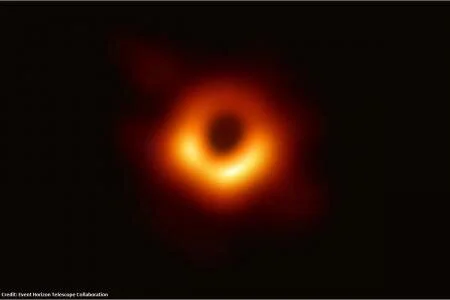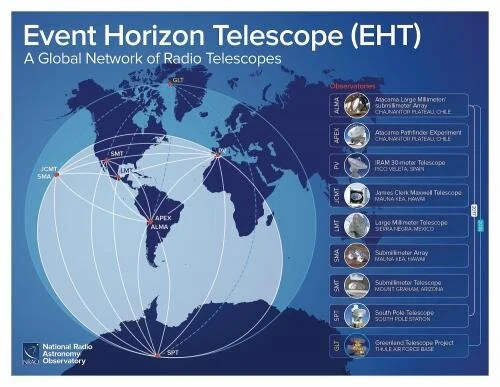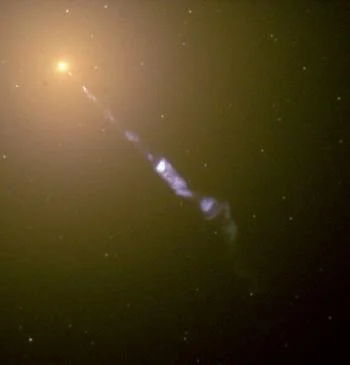Shedding Light on the Black Hole
by Bob Bonadurer
I’m not sure what is more amazing: Is it the very first black hole picture at the core of a galaxy called Messier 87, or is it the media splash it created? Regardless, our collective curiosity definitely spiked. It seemed to be pulled by the black hole’s enormous gravity — but black holes don’t pull in nearby stars or planets. More on that later — read on!
The name “black hole” is beguiling but a bit misleading. Darkness reigns because their gravity is so strong, not even light photons can escape. On the flip side, stuff gets crazy bright and hot — hundreds of billions of degrees Fahrenheit — before it is captured by the monstrous black hole.
The different colors you see are the varying heat intensities ferociously circling the invisible gravity well. The yellow-white areas show the most intense heat. Red areas are still powerful but a little less hot. The black part is the black hole casting its dark shadow on the bright swirling background.
The colors are false. Scientists from the Event Horizon Telescope (EHT) project created the image based on the radio energies near the black hole. Radio telescopes were used because they could get better resolution. Researchers combined eight telescopes across planet Earth to act as one giant 8,000-mile wide telescope! Not that anyone wants to get too close, but human eyes would probably see a white color with tinges of blue and red as the hot material moved toward and then away from the viewer.
The new black hole snapshot is impressive, but probably not captivating. Animations and artist drawings tend to be more colorful and spectacular. But there’s something about staring at a real picture, especially the first one. We can let our imaginations create the intense whirlpool. We can stare at the black hole itself, wondering where it all leads to. A cosmic tunnel — a wormhole to another galaxy? Or perhaps matter caught in its grasp becomes another universe?
The effect of a black hole has been photographed before. In 1998, the Hubble Space telescope took this picture of the same supermassive black hole at the galactic core of M87. The yellow light is the actual galaxy M87, a concentration of over a trillion stars. The blue jet emanating from its center is a black hole-powered stream of material that is moving near the speed of light. Astronomers first theorized of supermassive black holes at the core of galaxies almost 50 years.
The idea of a massive star with gravity so strong light could not leave its surface was first imagined in the 18th century by John Michell and then Pierre-Simon Laplace. Michell called them “dark stars.” In 1915, Albert Einstein allowed us to “see” the geometry of gravity in his general theory of relativity. His equations shed more light on the possibility of a black hole, but Einstein never warmed up to the idea they could be real.
The name "black hole" didn’t arrive until 1967 by American astronomer John Wheeler. Finally, in 1971, the first black hole, Cygnus X-1, was confirmed. It’s about 15 solar masses and is located over 6,000 light years away in the constellation Cygnus.
The Earth is in no danger from Cygnus X-1. This black hole does not pull the Earth any closer. Neither does the 4-million solar mass black hole at the center of our galaxy called Sagittarius A. Black holes are like a Venus fly trap. They can only capture you if you get too close — inside its gravity well — and lack sufficient speed to get out. If you move even closer, inside its event horizon, forget it. Nothing escapes that, not even light. Think of it this way: If the sun somehow squeezed itself into a black hole, with the same mass, the Earth would not fall in. (Though, surely we would be in trouble without its light and heat.)
Cygnus X-1 is puny compared to Sagittarius A at the Milky Way’s core. The mass of M87’s supermassive black hole is 6.5 billion solar masses. That’s a billion, with a B. This means it weighs as much as 6.5 billion suns! Yet the size of the black hole itself is small — only about the size of our solar system. The smallest black hole ever detected is about five solar masses. Check out this video for an awesome demo on black hole sizes.
— Originally published in Starry Messenger, May 2019
Robert Bonadurer, Planetarium Director at the Daniel M. Soref Planetarium in the Milwaukee Public Museum, has taught over 800,000 people the wonders of the universe. He has produced and directed over 25 astronomy shows for national and international distribution. One of his shows has won an international scriptwriting award.




